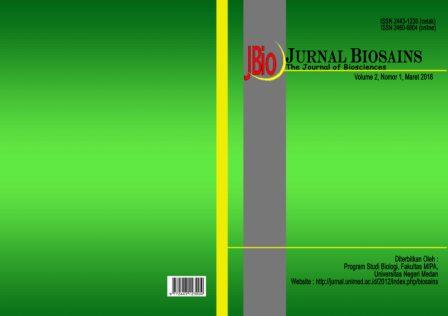Pemeriksaan Residu Pestisida Pada Tomat (Solanum lycopersicum L.) Di Pasar Tradisional Kota Medan
DOI:
https://doi.org/10.24114/jbio.v2i1.4026Abstract
Penelitian tentang pemeriksaan residu pestisida pada tomat (Solanum lycopersicum) di pasar tradisional kota Medan dilakukan dengan tujuan untuk mengetahui jenis-jenis residu pestisida yang terdapat pada tomat dan mengetahui kadar residu pestisida yang terkandung di dalamnya. Penelitian dilakukan dari bulan oktober sampai dengan desember 2015 di Laboratorium Kimia FMIPA Unimed dan Laboratorium PPKS Sumatera Utara. Penelitian ini menggunakan metode observasi, dimana diidentifikasi jenis-jenis residu pestisida yang terdapat pada tomat yang diambil secara acak dari beberapa pasar tradisional di Kota Medan. Pemeriksaan kandungan bahan organik sampel menggunakan alat spectroskopi infrared (SP-IR) dan kemudian kadar residu pestisida sampel dengan kromatografi gas (GC-MS). Hasil penelitian menunjukkan bahwa terdapat 2 jenis residu pestisida pada sampel yang diuji, yaitu klorpirifos dan metidation. Dari hasil pemeriksaan kadar residu pestisida sampel tomat dengan alat kromatografi gas (GC-MS), diketahui bahwa sampel tomat mengandung residu klorpirifos < 0,0085 mg/kg. Hal ini berarti sampel tomat yang diuji mengandung residu pestisida klorpirifos di bawah batas minimum residu (BMR) yang telah ditetapkan Badan Standardisasi Nasional (SNI 7313: 2008) yaitu sebesar 0,5 mg/kg. Kata kunci: identifikasi, jenis, kadar, residu pestisida, tomat, klorpirifos, metidationDownloads
Published
Issue
Section
License
For Authors Jurnal Biosains agree to the following terms:
Authors retain copyright and grant the Jurnal Biosains (JBIO) right of first publication with the work simultaneously licensed under a Creative Commons Attribution License (CC BY-SA 4.0) that allows others to share (copy and redistribute the material in any medium or format) and adapt (remix, transform, and build upon the material) the work for any purpose, even commercially with an acknowledgement of the work's authorship and initial publication in JBIO (Jurnal Biosains)
Authors are able to enter into separate, additional contractual arrangements for the non-exclusive distribution of the journal's published version of the work (e.g., post it to an institutional repository or publish it in a book), with an acknowledgement of its initial publication in JBIO (Jurnal Biosains)
Authors are permitted and encouraged to post their work online (e.g., in institutional repositories or on their website) prior to and during the submission process, as it can lead to productive exchanges, as well as earlier and greater citation of published work (See The Effect of Open Access).


